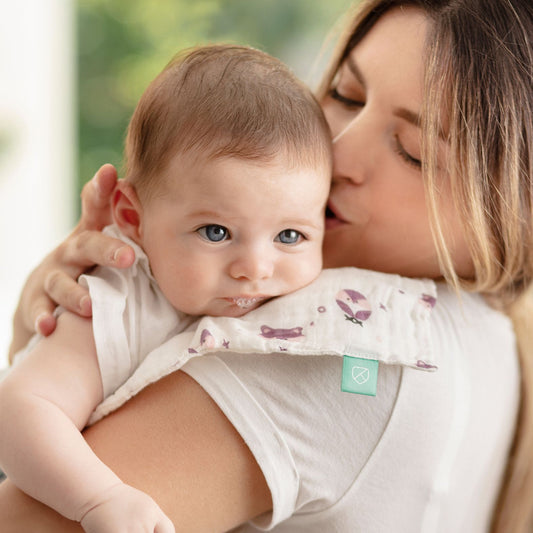How can we encourage a new-born baby to develop a regular sleep-wake cycle? First of all, we must recognise the various sleep phases that babies experience in the first months of their lives. Dr Rondine De Luca, Sleep Coach, tells us her secrets!
The typical questions that new mothers ask me are: why does my child only want to be held? Why does he wake up as soon as I put him in the cot? Why does he sleep so little during the day? Why does he always wake up crying? Why does he cry when I put him in the carrycot to sleep, even though he is sleepy?
I will attempt to answer all these questions in the following paragraphs.
The first months of a baby's life are the most exciting, but also the most difficult. Parents often feel insecure, full of doubts and questions and like they just don't know enough.
They tend to read and listen to everything and everyone: the Internet, their mothers, mothers-in-law, the paediatrician, friends, the upstairs neighbour....and ending up getting even more confused because everyone has different or conflicting answers.
Well, that’s why I'm here: to shed some light on this delicate topic for parents: the sleep-wake cycle from birth to five months.
What regulates a baby's sleep-wake cycle?
Let's start with a concept that is unknown to many: the Circadian Cycle. This involves our biological 24-hour clock.
Every day, certain conditions in our body are repeated around the same time, such as the sleep-wake cycle.
The circadian clock is a complex internal system regulated by multiple factors and based on external stimuli. The sleep-wake cycle is regulated according to the light and temperature of the environment.
Our Circadian Cycle starts to develop in the mother's tummy, and is closely linked to the mother's internal clock.
When we are born, our cycle continues to be in tune with hers for the first six weeks, influenced by the hormones and nourishment from breast milk.
Towards the sixth week, the body begins to regulate itself more in response to the external environment. This is why your baby's sleep seems so unsettled.
How does a new-born baby’s sleep work?
At birth, baby sleep is very different from adult sleep. It then transforms and gradually sorts itself out as the baby grows.
In the first period after birth, babies need care in order to survive. The mother's support creates a necessary dependency that gradually decreases along with risponde the acquisition of new motor, cognitive and emotional skills.
How can we encourage a baby to develop a sleep-wake cycle like ours?
The circadian cycle can be encouraged through exposure to light during the day and to the dark at night, which creates routines and schedules, albeit not rigid ones.
This only occurs after the fourth month, when the baby's circadian cycle becomes independent from the mother's cycle.
Many parents report baby sleep problems from this age onwards, without knowing that it is linked precisely to the fact that the child begins to seek his own sleep-wake cycle.
It is important to create a proper routine, which is connected to the circadian cycle.
A step back in evolution
The anthropologist A. Montagu teaches us that the human baby is the only mammal that completes its gestation outside the womb.
As a result of evolution, the human race has assumed the upright position and women began to give birth 'prematurely' after nine months of pregnancy for two reasons: because of the force of gravity pushing the foetus, and above all because of the exponential growth of the foetus' skull, as the hips and pelvis would not withstand the passage through the birth canal.
The baby needs a further nine months outside the uterus (exogestation) to finish forming.
During this period, he still has the same cycles and needs as when he was in the womb.
He still needs to feel the warmth of his mother, the scent of her body, her heartbeat and constant contact.
Why your baby calms down when held
Scientific research has shown that the premature separation of a new-born baby from its mother causes several negative reactions, such as disruption of the heart rate, sleep patterns and the hormones required for growth.
Moreover, being separated from the mother is very stressful for the new-born baby, as demonstrated by tests revealing an increased production of the stress hormone cortisol.
This is why so many babies cry constantly in the first months of life.
Feeling far from their mother makes them feel vulnerable and helpless. That's why they use the only defence mechanism they have: attracting attention by crying!
Many mothers do not understand the reason for these cries and are surprised that he suddenly calms down when held.
It is a mistake to think that the baby's being spoiled or is getting into bad habits when he only stops crying when he is held. In truth, at this stage there's no such thing as spoiling or getting into bad habits, as being held is the child's basic need!
Bear in mind that you are not spoiling your baby when you take him in your arms when he cries. You are giving him what he needs.
The importance of contact with your baby
Care based on constant contact between parents and child in the first months of life helps develop independence and autonomy.
Contact is expressed in various ways, such as:
- Breastfeeding
- Making the baby fall asleep in your arms
- Holding him in a sling close to his mother
- Sleeping close together during the day and night (always safely, of course).
All these forms of contact make the baby less nervous because he feels safer. He will not have to scream and cry to call his mother back.
The emotional component of the mother is essential when falling asleep: no one can fall asleep when they are afraid.
Bowlby defines this as attachment theory.
He argues that a child's attachment to his caregiver, established in the very first months of life, influences the child's entire development. Inadequate maternal care during early childhood prevents the personality from developing harmoniously.
According to the psychoanalyst, providing contact to your crying baby is the most appropriate response from the mother to a signal of discomfort expressed by the child.
In fact, the mother-child bond is not only based on the need to feed the baby, but on the recognition of emotions and needs.
How to foster secure attachment
Here are some actions that you can take from the moment the baby is born that help foster secure attachment:
- Breastfeeding is a key time for building secure att
- For bottle-fed babies, behaviours can be adopted that offer the warmth of breastfeeding, such as holding the baby close and maintaining eye contact.
- Respond sensitively to the baby's needs
- Spend quality time with him
- Skin-to-skin contact offers calming, reassuring and pleasurable moments.
- Baby massage
- Frequent contact: cuddles, games that promote physical closeness.
When does the baby's sleep-wake cycle start to change?
Thomas Berry Brazelton (American paediatrician, author and developer of the Neonatal Behavioural Rating Scale) argues that only after 4 months will the child’s nervous system be mature enough to allow him to sleep up to 6 to 8 hours at night, without needing to eat or require anything else from his parents.
This may happen even later, at around 6 months.
As we have seen, and as science confirms, it is so important for the baby to feel the closeness of his parents in his first months.
Contact, care, breastfeeding, the protection of his parents' arms... this doesn’t mean you're spoiling the baby or encouraging bad habits that he'll never get out of, but actually leads to a 'healthy addiction'.
Although this may seem a paradox, it provides the foundation for the child to find the security and stability he or she needs to become independent.
Sleep regression in the fourth month
This is when sleep regression occurs. Sleep becomes fragmented and the child lies awake for hours even at night.
This is a really frustrating time for parents, as they experience a deep sense of exhaustion that they have never felt before. It actually only lasts for a short while.
It is commonly referred to as sleep regression, but it is a key stage in your baby's development: sleep changes from a steady state to a dynamic pattern that includes light sleep, deep sleep and frequent awakeningscalled "checking".
These awakenings occur every 60 to 90 minutes during the night and 30 to 45 minutes during the day.
They are called checking because they allow the baby to wake up periodically and check his surroundings to make sure that everything is as it was when he fell asleep.
The bedtime ritual
After four months, you can start to teach the baby some rituals to associate with bedtime.
Think about it, we all have a routine for bedtime. We all complete the same actions in the same order before going to sleep.
This serves to create a kind of 'time limbo' to pass from day to night and prepare the body and mind for sleep.
That is why it is important to do the same for children, giving them time to get used to the idea that they will go to bed for the night.
The right time frame for the bedtime ritual is no more than 20 to 30 minutes. Any more than that risks overstimulating the child and having the opposite effect!
The ritual consists of a short series of simple actions to be carried out every evening so that the new-born baby remembers and recognises the pre-bedtime sequence.
The goal of the bedtime ritual is to calm the baby down. Knowing exactly what will happen next reduces stress and increases his sense of security, making it easier to fall asleep.
Bath time, reading a fairy tale, singing a lullaby... these are activities that can prepare the baby for what will happen soon: bedtime. Who knows, maybe they will have an effect on mum and dad too!
Dr Rondine De Luca – Sleep Coach
Dr Rondine De Luca she is an expert in children's sleep and specialises in solving sleep problems. In over 10 years, she has helped more than 1,200 families in Italy and abroad to regain sleep through her method “Le Fate della Nanna” (The Sleep Fairies). Follow her on Instagram @lefatedellananna. Her website: lefatedellananna.it








